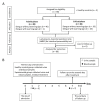Leaky Gut Syndrome Is Associated with Endotoxemia and Serum (1→3)-β-D-Glucan in Severe Dengue Infection
- PMID: 34835514
- PMCID: PMC8625530
- DOI: 10.3390/microorganisms9112390
Leaky Gut Syndrome Is Associated with Endotoxemia and Serum (1→3)-β-D-Glucan in Severe Dengue Infection
Abstract
The hallmark of severe dengue infection is the increased vascular permeability and hemodynamic alteration that might be associated with an intestinal permeability defect. However, the mechanisms underlying the gastrointestinal-related symptoms of dengue are not well characterized. A prospective observational study was conducted on patients with dengue who were categorized according to: (i) febrile versus critical phase and (ii) hospitalized patients with versus without the warning signs to evaluate the gut barrier using lactulose-to-mannitol excretion ratio (LEMR). Serum endotoxins, (1→3)-β-D-glucan (BG), and inflammatory parameters were measured. A total of 48 and 38 patients were enrolled in febrile illness and critical phase, respectively, while 22 and 64 patients presented with or without the warning signs, respectively. At enrollment, a positive LEMR test was found in 20 patients (91%) with warning signs, regardless of phase of infection. Likewise, serum endotoxins and BG, the indirect biomarkers for leaky gut, prominently increased in patients who developed severe dengue when compared with the non-severe dengue (endotoxins, 399.1 versus 143.4 pg/mL (p < 0.0001); BG, 123 versus 73.8 pg/mL (p = 0.016)). Modest impaired intestinal permeability occurred in dengue patients, particularly those with warning signs, and were associated with endotoxemia and elevated BG. Thus, leaky gut syndrome might be associated with severity of dengue infection.
Keywords: dengue; endotoxins; intestinal permeability; lactulose-to-mannitol excretion ratio; leaky gut; β-D-glucan.
Conflict of interest statement
The authors declare no conflict of interest. The funders had no role in the design of the study; in the collection, analyses, or interpretation of data; in the writing of the manuscript; or in the decision to publish the results.
Figures





Similar articles
-
Abnormal Blood Bacteriome, Gut Dysbiosis, and Progression to Severe Dengue Disease.Front Cell Infect Microbiol. 2022 Jun 17;12:890817. doi: 10.3389/fcimb.2022.890817. eCollection 2022. Front Cell Infect Microbiol. 2022. PMID: 35782108 Free PMC article.
-
Lubiprostone improves intestinal permeability in humans, a novel therapy for the leaky gut: A prospective randomized pilot study in healthy volunteers.PLoS One. 2017 Apr 14;12(4):e0175626. doi: 10.1371/journal.pone.0175626. eCollection 2017. PLoS One. 2017. PMID: 28410406 Free PMC article. Clinical Trial.
-
Septic Complications after Resection for Middle or Low Rectal Cancer: Role of Gut Barrier Function and Inflammatory Serum Markers.Dig Surg. 2017;34(6):507-517. doi: 10.1159/000475847. Epub 2017 Aug 3. Dig Surg. 2017. PMID: 28768258
-
Targeting gut barrier dysfunction with phytotherapies: Effective strategy against chronic diseases.Pharmacol Res. 2020 Nov;161:105135. doi: 10.1016/j.phrs.2020.105135. Epub 2020 Aug 16. Pharmacol Res. 2020. PMID: 32814166 Review.
-
The Role of Leaky Gut in Nonalcoholic Fatty Liver Disease: A Novel Therapeutic Target.Int J Mol Sci. 2021 Jul 29;22(15):8161. doi: 10.3390/ijms22158161. Int J Mol Sci. 2021. PMID: 34360923 Free PMC article. Review.
Cited by
-
Infection Dynamics of Dengue Virus in Caco-2 Cells Depending on Its Differentiation Status.J Microbiol. 2024 Sep;62(9):799-809. doi: 10.1007/s12275-024-00161-w. Epub 2024 Aug 30. J Microbiol. 2024. PMID: 39212866
-
Loss of Gut Barrier Integrity In Lupus.Front Immunol. 2022 Jun 20;13:919792. doi: 10.3389/fimmu.2022.919792. eCollection 2022. Front Immunol. 2022. PMID: 35795671 Free PMC article. Review.
-
Neutrophil Extracellular Traps in Severe SARS-CoV-2 Infection: A Possible Impact of LPS and (1→3)-β-D-glucan in Blood from Gut Translocation.Cells. 2022 Mar 24;11(7):1103. doi: 10.3390/cells11071103. Cells. 2022. PMID: 35406667 Free PMC article.
-
Gut Barrier Damage and Gut Translocation of Pathogen Molecules in Lupus, an Impact of Innate Immunity (Macrophages and Neutrophils) in Autoimmune Disease.Int J Mol Sci. 2022 Jul 26;23(15):8223. doi: 10.3390/ijms23158223. Int J Mol Sci. 2022. PMID: 35897790 Free PMC article. Review.
-
Abnormal Blood Bacteriome, Gut Dysbiosis, and Progression to Severe Dengue Disease.Front Cell Infect Microbiol. 2022 Jun 17;12:890817. doi: 10.3389/fcimb.2022.890817. eCollection 2022. Front Cell Infect Microbiol. 2022. PMID: 35782108 Free PMC article.
References
-
- World Health Organization Ten Threats to Global Health in 2019. [(accessed on 10 August 2021)]. Available online: https://www.who.int/news-room/spotlight/ten-threats-to-global-health-in-....
-
- World Health Organization Dengue and Severe Dengue. [(accessed on 11 August 2021)]. Available online: https://www.who.int/en/news-room/fact-sheets/detail/dengue-and-severe-de....
-
- Zheng B., Wang H., Cui G., Guo Q., Si L., Yan H., Fang D., Jiang L., Jiang Z., Zhou J. ERG-Associated lncRNA (ERGAL) Promotes the Stability and Integrity of Vascular Endothelial Barrier During Dengue Viral Infection via Interaction With miR-183-5p. Front. Cell. Infect. Microbiol. 2020;10:477. doi: 10.3389/fcimb.2020.00477. - DOI - PMC - PubMed
Grants and funding
LinkOut - more resources
Full Text Sources

